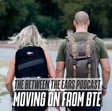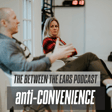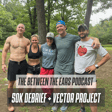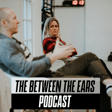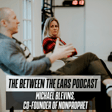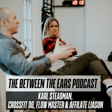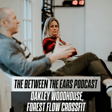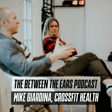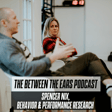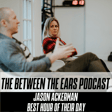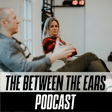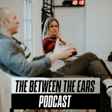Become a Creator today!Start creating today - Share your story with the world!
Start for free
00:00:00
00:00:01

Chris Hinshaw, founder of Aerobic Capacity
Chris Hinshaw, founder of Aerobic Capacity, joins us to discuss coaching CrossFit Games champions, lessons learned as a professional Ironman, his experience doing The Dose workout, tools and practices to improve your endurance, and more good stuff.
Chris is a wealth of knowledge, super generous with his time and energy, and packs this episode with lots of value.
Chris can be found at https://www.aerobiccapacity.com/
Instagram @hinshaw363
Please subscribe, review, and/or share if you find this valuable.
Curious in The Dose?
Join for $9/month or $99 for the year at https://ethos.btwntheears.com/the-dose
Transcript
Podcast Introduction and Guest Overview
00:00:00
Speaker
Welcome to the new format of the Between the Years podcast. Instead of telling you right now what's new about it and what we've changed up, I'm just going to hope you can pick it up on yourself. I think you'll be able to. We made it fairly obvious.
00:00:15
Speaker
And if you do, let us know how you like it. The best way to do that is to subscribe, review, and share, and any or all of those is very much appreciated. So thank you in advance for supporting our show.
00:00:31
Speaker
We don't know really what we're doing or where we're going with it, but we just hope to talk to interesting people doing valuable things in the fitness and mindset space that we have relationships with or old or new and bring them to you. Hope you enjoyed the listen. Please let us know how you do like it, what you find valuable or what you'd like to hear more of and appreciate again your support. Thanks.
00:00:59
Speaker
So this episode we are interviewing Chris Hinshaw. Chris is a long time friend of ours and founder of Aerobic Capacity. He's widely considered one of the top endurance coaches in the world.
00:01:15
Speaker
And he's internationally known for his extensive knowledge and practical experience developing aerobic capacity in athletes of all experience levels. He uses a comprehensive cutting edge approach to training. We've taken his seminars. We've had many conversations with them.
Athletic Achievements of Chris Hinshaw
00:01:31
Speaker
And what we can say is Chris is a big brain, lots of experience and incredibly passionate about what he does. He's also really good at it.
00:01:42
Speaker
He's coached 34 CrossFit Games champions, 50 plus CrossFit Games podium athletes. He's a 10-time Ironman competitor. He's been in the CrossFit space for over 14, 15 years. He is a subject matter expert on all things aerobic capacity.
00:02:01
Speaker
He's a professional athlete who is an all-american swimmer. He finished second place in Hawaii, Kona overall, World Championships, first place finish at Ironman Brazil. The dude is a stud when it comes to endurance training, but he's also a stud at coaching. His endurance coach to hundreds of athletes and professionals
00:02:25
Speaker
that does not only include CrossFit or recreational fitness enthusiasts. He does some amazing work with FDNY, the Marines, and Olympians and Brazilian Jiu-Jitsu players, world champions around the world.
00:02:44
Speaker
Chances are you do CrossFit or you've heard of CrossFit. So some of the people that Chris has coached include Matt Frazier, Rich Froning, Justin Medarios, Jason Kalipa, Camille LeBlanc-Bazinet, Katrin David's daughter, Tia Claire Toomey, Kristin Halta, Kara Webb, Sarah Sigmund's daughter, Julie Fuchet, Roman from Russia, Haley Adams. The list goes on and on and that's just the individuals.
00:03:14
Speaker
We dive deep into some really cool topics. I found it super valuable. I learned new things, as I always do when we talk with Chris. And frankly, I didn't want the episode to end, but we're trying to keep it to like an hour. So we had to cut it short.
Adidas Project Personal Best
00:03:29
Speaker
We also dosed Chris, which was really cool. He did our dose, and we chatted about his experience, what that highlighted, what that brought up for him, what that piqued his curiosity on. And we got into some practical matters as well, beyond just cool philosophical conversations. Also practical tools that athletes, or especially CrossFit athletes, can do a workout to kind of identify this type one, type two muscle fiber
00:03:57
Speaker
Dominance that Chris gets into and explains why that's actually really important. So that's pretty cool and we also chatted a bit about Chris's Current project with Adidas. Yes Adidas. It's called project personal best I'm gonna save the details for Chris to explain it, but I will say it is really really cool and
00:04:19
Speaker
not just for professional athletes and Chris's desire to bring quality professional coaching to everyone regardless of their means or access is not only like really cool but I also think like really noble and I have a ton of respect for that so
00:04:37
Speaker
We enjoyed this conversation tremendously. We hope you enjoy it. You can find Chris at aerobiccapacity.com. He's on Instagram, Robic Capacity. Chances are if you do any sort of running, rowing, cross-fitting, et cetera, you're going to find this conversation really valuable. Thank you for listening. Here's the episode.
Coaching Strategy and Military Comparison
00:05:30
Speaker
Hello. Hello. Hello. Chris, welcome to the Between the Years podcast. Thank you for being on and always being so generous with your time. Well, thanks Bill. I don't know how we're going to do this in an hour. I know. We'll have to add part two and three and four, but it's good to, uh, to have some rails to keep us, you know,
00:05:57
Speaker
The last time we were chatting, Kariana and Heidi had to be like, okay, enough. Well, we got kicked out of the restaurant. They were closing. Otherwise, we would have stepped in there. They turned the lights on and they're putting the stools upside down. Yeah, it's good stuff. For dinner at your house, Heidi. Yeah, dinner at your house. You got to work tomorrow morning early. We got to go. Yeah. But that's a good thing. That's a good thing. I know. It's really nice. Really nice. Yeah. I do have a tendency to struggle
00:06:27
Speaker
in conversations and I always find it interesting when something that somebody has done in their past or their content dives deep and all of a sudden it turns from I got to get out of here because I'm bored to death to where it's like I want to see where this goes and yeah we've had a couple of good ones and
00:06:53
Speaker
Yeah. I think that's why it's going to be tough to finish this in an hour for me. So just keep it short. All right. I'll be the cutoff. I'm good at that. Well, this part we can keep a little short. How, give us a little background, like obviously how we know you, what your, give us a little, obviously people know who you are, but for someone who might not or a little bit of the background. So I'm an endurance coach or a specialist, uh, primarily in the,
00:07:21
Speaker
the CrossFit space, but I do a lot of work with first responders, military, fire, law enforcement. My background as an athlete, I was a swimmer as a kid, very late in developing. I got into the sport of triathlons. And as I started to develop when I was in my late teens, early 20s, I had some success. I got sucked into Ironman distance events.
00:07:51
Speaker
And yeah, I think if you're race enough and you have some good genetics, you end up doing well. And that set me on a pretty, like a positive trajectory. So in a nutshell, that's my background as a coach, as well as an athlete. And some of the highlights as an athlete,
Mental Aspects of Endurance Sports
00:08:16
Speaker
like we're working.
00:08:17
Speaker
winner of Iron Man, winner of major situations. That's just like, Hey, I signed up and I did it. Not that there's anything wrong with that. But yeah, I ended up but yeah, I got second place in the world championships. I got second in Kona. I placed in the top 10 in Kona a few times. Yeah, I was a specialist, you know, it's it's kind of a curse, right? That
00:08:43
Speaker
To be able to be good at something. Unfortunately that something takes nine hours You know, I wish it was like could you imagine being 100 meter sprinter and actually get tired and you're already done You don't get tired while doing something right? Yeah to me. I but I enjoyed it. I I find Endurance training very appealing. It's very cathartic. It's very thought-provoking. It's it's internal and
00:09:13
Speaker
I'm, I'm, I'm what you call a social introvert. I mean, I could have a conversation, but it's difficult for me. I rather just deal with my own thoughts. And so endurance training, you know, 10 hour bike rides, it was, it was appealing to me. Um, and it still is appealing to me. That's why I struggle with short time domain, high intensity, CrossFit workouts. I don't find enjoyment in that because it's not thought provoking in the moment.
00:09:43
Speaker
Right. Do you find it thought provoking, like, you know, kind of like a wave crashing and you see it come up the coast, like thought provoking after or just generally not in any way? I find it thought provoking afterwards. I'm very strategic in the way in which I go about things and I'll give you an example. So if I look at a workout that I've never done before,
00:10:09
Speaker
one of the things that I like to do is estimate how much time it's going to take me down to the second. And I look at all the variables and I think about my strategy in it. And I really, really try and take ownership in that approach. And then afterwards, I think about how well I did in my estimation of total time and also where were the opportunities for me to improve. And I find that
00:10:38
Speaker
a lot of individuals, they just go in and just do what they're told. They freestyle it and they walk out and never think about it. They just think, I just did the workout and there's value in that, but not the highest value. If they took some ownership, if they took possession of it, like I'm saying that I do, there is more value because you now have created like a history. You have,
00:11:06
Speaker
something to look back on and reflect because you own it. And I find that a lot of athletes that right now, today, they say they want to compete and get on the podium, but they don't take any ownership. Well, if you don't know where you've been, how do you know where you're going? Yeah. And so that's what I think about, you know, as far as like those short workouts, I try.
00:11:35
Speaker
to take ownership in it to help me do a better job the next time. And that's ultimately what we're trying to do, to maximize the value of that training time, to maximize your adaptation. I mean, why would you go there and train and suffer and get 80% of the potential value?
00:11:56
Speaker
Yeah, that trap of the 80% is far and wide and very common, I think, to have, you know, when you're walking, when being military, whatever, when you're walking through,
Endurance Training for CrossFit Athletes
00:12:07
Speaker
typically, it's like a wooded area, but
00:12:12
Speaker
the ground that you're walking on will influence you and push you in certain directions. And downhill is typically where you'll naturally walk if you aren't paying attention. And of course, if you're walking down, typically where we do a lot of training, like you're going to get wet and it's going to be generally miserable and it's going to be kind of shitty and additional to potentially not being as tactically sound.
00:12:37
Speaker
But that whole component of just settling in or mindlessly having the environment or the terrain dictate where you go, yeah, to your point, removes you from being able to guide and orient to where you really want to go or where you're trying to go. And it's almost that the 80% kind of channels you into this valley of, not mediocrity, but limitation, I suppose. Yeah, a lot of people ask me, when you do an Iron Man,
00:13:06
Speaker
full distance Ironman like Hawaii Kona. What do you think about? And, you know, like you just said, do you following the terrain and you go to the you follow the easiest path? Well, when you're doing something at maximal effort for nine hours, are you really truly thinking or are you trying to disassociate yourself from your suffering because you are suffering? I mean, there's think about
00:13:34
Speaker
Imagine you do a 2.4 mile ocean swim. You ride 112 miles across the lava fields of Hawaii, battling in some cases 30 to 40 mile an hour headwinds. And you're now six hours in and you got to run 26.2 miles in the heat of the day of Hawaii. And you're trying to race at maximal effort based upon that amount of time. And so you're on, it's called, you know, on the rivet where, you know,
00:14:03
Speaker
bike seats used to be made out of leather and there used to be a rivet right on the end of the bike seat. And so you'd just be right on the edge of that rivet the whole time. And you know, what do you think about? Well, you are trying to disassociate with your, your fatigue, your pain, and only think about strategic moves. And that is the hardest skill for an athlete to learn. And I must assume in the military under fatigue,
00:14:32
Speaker
you make bad decisions and you teach how to stay strategic as that fatigue builds and builds and builds. And that's where I see the greatest failure in athletes, especially within the CrossFit space, because they don't go long enough to deal with that negative propagation and how it interferes with strategic thought.
00:15:00
Speaker
And would you say that when you see athletes at the games, that's not that it's a long workout per se, but day two, day three, they're kind of in that long and they're in the hole and they have it because their body has now taken on suffering. It might not be one effort, obviously, but what's your experience like? I mean, obviously that's an area that you've experienced. That's one of the key areas. I mean, this is where,
00:15:27
Speaker
You know, Camille, I got to tell you, so I started working with Camille Leblanc-Bazinet, who won the CrossFit Games in 14. I started working with her in June of 2013. I was introduced to her. That's kind of funny. So I was introduced to her. She shows up one day at the track and I was doing a workout with Jason Calipa. And it was a month out of the first games that I was really, I was going to go to. And I'd been working with Jason for six months.
00:15:55
Speaker
She shows up and just jumps into the workout and I didn't know her But anybody was welcome and after the workout she comes up and she says so you'd be my coach and I'm thinking to myself like what like we're not even talking about and and she said so you'd be my coach and we go to the game and If we win you save my coach if we don't do a win then
00:16:25
Speaker
then I don't ever call you again. And I'm like, I'm like, so rude. But then I started backing up a little bit and I'm like, you know, this individual is right. Like what what we really need to be doing is we need to to deliver greatness because her window of time is so short. And Camille was a smart athlete, right? She has an engineering degree and she recognized the
00:16:54
Speaker
like you said, Karyan, the accumulation of fatigue, right? Because the CrossFit Games is an endurance competition. And she told me, she said, I want to work with you and I want to do everything possible to be in the best position on the last day. And that to me was genius, that she recognized that value on that last day. And how can we put you in that best position
00:17:25
Speaker
to dominate. I mean, look at Rich Froning. That's why he's the greatest, because he recognized that that's the day that the champion is actually crowned. Yeah. Yeah, growing up, I played soccer at high levels. And I remember my dad, who was my first coach. And even once I kind of advanced beyond where he was coaching and different things.
00:17:50
Speaker
He told me that, I forget what in the World Cups, it was like 80% of the goals were scored in the last 10 minutes. And of course there's another 20% of that, but it's such a great thing to look at and a frame to have your training be not built around entirely, but significantly influenced by, hey, when I can then learn to recognize what it's like,
00:18:20
Speaker
struggling when somebody's, you know, eyes wide open and they're breathing into their chest and they're looking at the ground. It's like, oh, I'm going to go after you harder now. And I'm looking up at those moments of fatigue. You know, there's this quote that fatigue makes a coward of us all or something like that. I know Churchill said it or something, but like, yeah, when we get tired, we make mistakes and how just
00:18:46
Speaker
incredibly effective that is as a teacher, as a natural teacher, and endurance being almost this hedge against the inevitable atrophy of your physical, your psychological skill sets. And to improve and to move that and to prevent that atrophy from occurring is almost this beautiful notion of endurance and where it's really a beautiful pursuit, I think.
00:19:12
Speaker
Well, that's what it's interesting after elite level crossfitters. When they leave CrossFit here, they focused on shorter time domains. There is an interesting evolution of that, of that athlete. They want to test their ability to endure. They want to know where the edge of their boundary is in terms of, of, of endurance and
00:19:39
Speaker
It's fascinating to see that migration over where it's like, oh, now I get it. And that is the interesting thing for me is that here, these champions are now going long and their perspective is now different. And what they're recognizing is the contributions and the sayings that I kept telling them all the time.
00:20:06
Speaker
that
Balanced Training and Performance Improvement
00:20:07
Speaker
you need to have a better balance. And what I meant by balance is a relationship with that other side of the equation. And I think that that's where the growth is going to occur on the elite level, a recognition that that segment of what we think is long is not long. And where does it then take the sport? And there's very few athletes, like Haley Adams is one of the very few anomalies out there
00:20:35
Speaker
in terms of her ability that she tomorrow can run 13 miles and compete the next day. And she would run that 13 part. That's a very rare athlete. Now, genetically people may think, oh, that's why she's not strong. No, no, no. She has that background and she has an understanding and an ability of what 13.1 miles of running means.
00:21:02
Speaker
If you've never run 13.1 miles, you have no idea what you're talking about. And that's why you see like these crossfitters that like to run a marathon. You know, I've seen it before where, uh, you know, I got a gift card into Boston. I'm going to run it and I'm just going to make myself run 26.2. Yeah. Good luck with that. Yeah. The folks all afterwards, it's like, I don't know what happened. I was going 14, 15 minute miles and I was trying to run, but I just couldn't. I don't know why.
00:21:32
Speaker
Yeah, well, now you'll rethink your day four at the games. Yeah, it is. It is interesting how we have on the one end the duration of endurance and, you know, how long means something. It's not like 20 minutes, 30 minutes. Murph is not long. No, no, no. Like these workouts at 30 minutes to 60 minutes. Like that's not really long, but of course within the crossfit space and functional fitness, whatever that might be longer than normal, but that doesn't mean long.
00:22:03
Speaker
And there's also this thing about short as well. And the shorter a different type of pain occurs or a different type of suffering. I love this notion of being strategic with your suffering that you're talking about and obviously taking your courses and knowing, you know, just learning from you. That's one of the things that you really empower and educate people on. But we've also noticed how like, okay, you're not going long.
00:22:32
Speaker
But if we say do something in less than a minute, there's this hesitation to do that as well. And specifically, we have this program. The first we're at the dose, the workout. You did it. You did it. You've been dosed. That was on the complete other side of the spectrum when it comes to endurance. How did your dose workout go?
00:23:02
Speaker
looked at that workout. First of all, I really like the way that workout is structured. I like that it takes into account an individual's body weight. I like that. I think that's very important because on a piece of equipment, an echo bike or a biker,
00:23:24
Speaker
your weight is supported by the object. And so a bigger person, a person with more lean muscle mass is going to generate more wattage. They're going to generate more power output and it's unfair. And so what you did is you made it so that that argument goes away. And I like that. It's like, okay, this sounds reasonable. What I end up doing is I look at a workout like that and, and you know, 10% of my body weight, I weigh 116 to 163 pounds.
00:23:55
Speaker
So 16 cows. Um, and then to get up to 50%. Okay. So I look at that and I go, okay, so I've got, you know, to get up to 50%, I've got to do five rounds. Um, we actually made a mistake and did 10 rounds. Oh my God. I love it. I love it. And so 10 minutes to me is a frightening time domain.
00:24:19
Speaker
Um, five minutes isn't that bad. It's basically a mile. And it's not that scary for me in a five minute time domain. I knew if I got to minute four, I'd be home free. And in a workout like that, I think that's a manageable time domain. Um, but 10 minutes is a scary time domain because a lot of damage can occur. So if I look at a 10 minute time domain, I'm thinking, you know what?
00:24:45
Speaker
Round eight is going to be really hard for me. But if I make it through round eight, I know I could do nine and 10. What what I took was that strategy. My job is to just be patient and just get to round eight. If I get to round eight, then I know I'm close enough to the finish line where I can bring it home. And the key was is is what level of fatigue, what damage would be created because I've never done this workout before.
00:25:15
Speaker
Um, by the time I got to round eight and I always want to make sure that I know approximately how much pain I will be in at that sticking point. Because if I underestimate that amount of pain, I will underperform. So what I'm trying to do is match my, my perceived amount of pain before the workout with the actual amount of pain at that particular point. And so there's balance and that was a hard thing for me because
00:25:45
Speaker
Um, the other piece was, which probably makes it more balanced is that the gym, uh, CrossFit for Vancouver, where we go, they were using all the echo bikes that day. So I had to do it on a biker. Now biker for me is not that bad. Um, so I was pleasantly surprised at when I got to eight minutes that I felt better than I thought I was going to feel. No, no, don't think that I felt great. Oh.
00:26:12
Speaker
but I felt better, which was a confidence boost for me. And so, yeah, I walked out of there and I felt good about it. Heidi, my better half, did it side by side and it rocked her. Now she went to Pilates that morning, which I don't know what she was thinking. And so if she was here, she would tell you that, you know, that was a devastating workout. But luckily she was the individual that picked the
00:26:39
Speaker
10 rounds. Like I just, you know, it's funny that perception. So we did this workout every week for four weeks to see the progress. And I mean, I have a sense of what 13 calories is like on the echo bite, but I've never done that every minute, 13, you know. And so I got on and I started and within 30 seconds,
00:27:06
Speaker
I said to Bill, I can't do this. I can't do this. I was 30 seconds in. No, you finished the first round. Okay. Maybe I finished first round. It was within 90 seconds. And you know, Bill's like, just keep going. I mean, and the only thing like, first of all, can't do this. I mean, you might have to take a minute off, but you can like, but the pain and realizing and projecting like, wow, I didn't, I overestimated. I underestimated the pain. I overestimated myself. Yeah. Like,
00:27:35
Speaker
And now I didn't stop, but I might as well because that popping up was like, you know, then week two, I was prepared.
Building Tolerance and Addressing Weaknesses
00:27:45
Speaker
I knew the pain and someone had said to us like,
00:27:49
Speaker
in a recent seminar, when they know the pain, they don't want to go back and do another workout where they already know the pain. And I found that kind of interesting. But in many ways, for me, like knowing the pain that's going to come, you're kind of prepared and like, OK, and am I willing and am I ready to to to endure that? That's interesting to me. So it takes me back to when I started CrossFit and I
00:28:17
Speaker
I dreaded those short time domains because it was a space that I didn't actually experience. I wasn't ever trained in that way. And in order to get myself to where I wasn't afraid or intimidated, where I was willing to take an extraordinary risk in a workout,
00:28:43
Speaker
I had to take it into my own space where I was safe and that was in the movement of running. And so what did I do when I started CrossFit? I was starting to be able to run again and it was like, you know what? I'm not going to go out and do an easy run today. I'm going to do CrossFit style. And so what would I do? The first thing that would pop into my head, which was the only thing I didn't want to do, which was either a two mile time trial or a 5k time trial.
00:29:09
Speaker
And I would do five case three times a week at maximal intensity. And I did it for probably four months where it was like, it was either two miles, sometimes a mile and a half would pop into my head, but it would be the first thing that I didn't want to do. And that was my workout. And it was always a max effort time trial after about four months. I don't care anymore. Whatever you want to give me. And that was, and that I wish I had when I competed.
00:29:37
Speaker
because I would avoid courses that had hilly running, that required more power output. I liked hilly bike ride because my power to weight ratio, but not running on trails. And so I would avoid it. And I wish that I had this, this, this ability back then where I wasn't running away from something because I, I felt I wasn't good at it. Yeah. And it reframed everything for me.
00:30:07
Speaker
Like that's what CrossFit did. It made me realize that the other side of the equation, that anaerobic lactate tolerant side of the equation, like this workout, how the value would contribute in terms of being well rounded. Yeah.
00:30:26
Speaker
Yeah. And that's why the mindset, you know, like we wrote up about and you know, the concept mindset, psycho psychological intention with it is this notion of tolerance. It's so important. I think that people understand also your point about it. So tolerance and exposure are, you know, peanut butter and jelly. Yeah. In order to improve our tolerance, we need to titrate or gradually increase our exposure to something.
00:30:55
Speaker
However, if the peanut butter is tolerant and the jelly is exposure, the bread that keeps it together is safety and we need safety. And this is true in clinical psychotherapy. This is true in strength and conditioning and certainly in anecdotal evidence as supported by you, like a world-class athlete saying, look, if I'm going to get better at this thing, that's new, that I don't have as much exposure to,
00:31:22
Speaker
And I'm perceiving I can't quite tolerate what's required to do that, because it's just new. It's just something I haven't been exposed to. I need to find safety in something that I can expose myself to, to build that tolerance, the presence of those signals, physiologically, what it's like to be like, oh my God, my lungs literally just exploded. My legs are painful, which is feeding upstairs to, I can't, I'm not good, ba-ba-boom, all of the psychology and how,
00:31:51
Speaker
training tolerance has such spillover to outside of the gym. And it's so, I think, valuable to know that like, okay, hey, we want to get better at tolerating something. Yeah, we need to do it more. But we also have to have it contained within a
00:32:11
Speaker
know, an experience that is safe, otherwise our nervous system and just the natural protective responses are going to reject it and say, No, and that's intolerance. That's what we're not we're not going to be tolerant of. And it's really cool to hear that that also plays into not only what you experience, but also like you you help athletes
00:32:32
Speaker
improve upon what they can tolerate also by not giving them unrealistic expectations, but individualized custom plans. I mean, you've told us the story where you're, you know, individualizing a workout for, for a battalion of Marines, like in 10 seconds, and I'll have everybody, you know, and it's just, it's just really cool to kind of, you know, see how this notion is
00:32:58
Speaker
understood, practiced, and also shared within this kind of fitness exploration we're all in. Well, I think that's the important piece is that an individual must take some accountability. They must be willing to recognize their own individual strengths and weaknesses, their limitations. And like you said, even in your daily life, avoidance of an issue
00:33:26
Speaker
is not going to make you more well-rounded. It's not. And that's what I did as an athlete. I avoided events that were not in my sweet spot. And that was a mistake because every single time that I would encounter an obstacle that was not something that I trained, it would be perceived as a negative. And that would take me down a rabbit hole.
00:33:55
Speaker
And you never as an athlete want negative thought to enter because there's always a risk that it propagates. And so that was a weakness. And the problem was I knew it, but I didn't do anything about it. And now as a coach, what I'll do is I will write a workout and it will be a simple workout. And it will be with a group of people and here's the workout. We're going to do 10 rounds and it's going to be a 10 second sprint.
00:34:24
Speaker
followed up by one minute easy, 10 rounds. And I want that 10 seconds sprint as fast as you possibly can go. The people that are fast twitch, speed, power, strength athletes, right? Better in short time domains. I want you on the right side of the room and the endurance athletes, the ones that are ability to go long, the ones that have a great ability to recover. I want you on the left side of the room. Now, before the workout, what I want you to do is I want you to be thinking about
00:34:54
Speaker
What should your priority be based upon your strengths and weaknesses? So me, I'm an endurance athlete. So in this workout, what should be my focus? And what my limitation is, my inability to recruit fast-twitch fibers immediately. Where if you take a fast-twitch dominant athlete at three, two, one, go, all of their fast-twitch fibers fire, their problem is they can't shut them off. And if they don't shut them off in about a minute and a half, they're done. They're going to walk.
00:35:25
Speaker
And so my focus is always on the acceleration into speed that I need to be really focused on that trigger point. Now the opposite side, the people on the other side of the room, those fast-twitch dominant athletes, their job is to not even think during the sprint because that will happen on autopilot and it's going to be enjoyable to them. Their job is as they transition from that sprint to the recovery,
00:35:54
Speaker
How long does it actually take for them to get back in control of that slow speed? And so if you don't know, right, then who you are, then how do you know how to attack a workout like that? And you know what you'll do? You just go through the motions and that you're good at. And, and you know, where do you get mediocrity at the end? Yeah. Yeah. Yeah. And all you're doing is avoiding.
00:36:21
Speaker
The thing that is preventing you from getting to the next level. And I have a lot of regret when I think back on my days as an athlete, and I could have been better. And this avoidance was the thing that got in my way. And I didn't fix it until I got into CrossFit and was introduced to.
00:36:48
Speaker
another side of the equation, I thought that I was dealing with the whole spectrum when in fact, I was only dealing with half.
Identifying Strengths and Weaknesses in Training
00:36:59
Speaker
I can't help but think about how so one of our things is that like our mantra sort of between years is educate, empower, engage, and the education, we want to provide people whatever, basically the what different types of things, knowledge, blah, blah, blah.
00:37:17
Speaker
empower them is this notion of, hey, I can, I can do this, right? This personal empowerment, this, maybe it's courage, maybe it's bravery, maybe it's confidence, belief, curiosity, and then engage is like, okay, the actual experience to act and to live and to do this thing. And in hearing you talk about, you know, the 10 rounds, 10 seconds into one minute, the type
00:37:39
Speaker
one athlete is going to do, et cetera, the type two athlete is going to do this or that. In your experience, have you found a
00:37:48
Speaker
approachable test that people can engage in that might educate them as to are they a type two dominant athlete, a type one, like without going to, you know, Stanford School of Biomechanics and getting some, you know, laboratory tests done. Anything that you've come across that kind of gives a decent idea on what they might default to or be? Yeah, it's funny. I mean, I had biopsies done and that's how high
00:38:17
Speaker
and a decent idea. And I mean, it's if you know somebody and you're in the right place, it's not a bad process. But, you know, so there is a couple of different tests. It's interesting, like when you when you look at. Basketball players or volleyball players when they they jump and they take their approach, whether it's, you know, two step, three step approach and then they make the jump.
00:38:46
Speaker
What I look for is do their knees bend or do they essentially pogo? And an endurance, slow Twitch athlete will bend because they're not going to have that reactive force that a fast Twitch dominant athlete would do. And so would you would experience. And so you would look for the bending of the knees. Now in terms of, of running,
00:39:11
Speaker
There is a test that I create, and this was the one that I gave to the FFI, the force fitness instructors at Camp Pendleton. And what it was was a 100 meter sprint, but that sprint speed needs to be at your 400 meter PR pace. So if you take your 400 meter time, let's say it's a minute, you can run a lap around the track, then you would have to do that 100 meters in 15 seconds.
00:39:39
Speaker
After the 100 meter sprint, you're gonna jog at whatever speed you want, the remainder of that lap, so 300 meters. You're gonna do that five times with no rest. You must hit that 15 second or that pace for the 100 meters, which means that you run that 300 as slow as you want in order to make that time. Now, what you're gonna do in this workout is you're going to add up the total amount of time that that five laps takes.
00:40:09
Speaker
All right. At the end of the five laps, you're going to have this time. And what you'll end up doing is removing, subtracting out your total sprint time. So in this case, you remove 75 seconds. And what was left was your total amount of jog time. Well, how much jogging did you do? Well, you did 1500 meters of jogging. Now you could come up with your average jog pace. The relationship between your sprint and your jog is two to one, meaning
00:40:38
Speaker
If it took you 15 seconds per hundred meters to do your sprint, then you optimally should have a 30 second jog average for a hundred meter pace. If you do, you're ideal. But what if you have an average jog pace of 32 seconds compared to your sprint of 15? That means I've got to improve my jog by two seconds. So what should you work on? Your endurance.
00:41:07
Speaker
Likewise, what if it's on the other side of the equation where you have a 16 second sprint time and a 30 second job? Well, I gotta get my 16 down to 15, I need to work on speed. And there's a very simple way that if you wanted to do it in a workout of whether or not you need to spend more time on your speed, your strength, your power, or you need to work on your aerobic, slow twitch endurance.
00:41:35
Speaker
And that's what I gave to the FFI athletes. And for them, they use their 800 meter combat fitness test time, which was just enough. It was fine. Yeah. You have to, you're right. You, one of the things that I have to hand it to Glassman that he, that he made very clear was your result, you have to have measurable results. Otherwise, how do you know you're getting better?
00:42:04
Speaker
And as a coach, if I don't provide something measurable to an athlete to use that result of designing a progression or some next workout, why would they do it? They have to be proven like this is why I'm going in this particular direction. Right. Like like a lot of athletes, they're doing zone two training. I love it. But remember,
00:42:35
Speaker
your muscles are actually doing the work, not your heart. And so is it your speed that is limiting your performance or is it your cardio respiratory system? Which one of those is preventing you? And so a lot of athletes will do a zone two workout for an hour and they'll start out at a decent rate of speed. And then they'll end up at that same heart rate from start to finish, but they'll end up walking.
00:43:01
Speaker
Well, what did the muscles learn to do in that workout? And so that's really the problem. And that's where you need someone that gives you a little bit better guidance of like, we've got to make sure that we know which one of those. Yeah. The tool appropriately. Is it your heart rate that's limiting you or is it your muscles that are limiting you? Yeah. Because the muscles at the end of the day must do the work.
00:43:28
Speaker
And I find that appealing with Glassman said, right? It's got to be empirical. You've got to be able to measure it. Otherwise, how do you know your direction? Sure. So I thank God I'm a finance guy and I love spreadsheets. I mean, if I can share my screen right now, I would open up something and it's just littered with just beautifulness. It's so beautiful.
00:43:53
Speaker
Um, as a former accountant, that scares the shit out of me. Um, you love it. You know, yeah. Um, well, speaking of that, one of the things that you just recently, um, I mean, I guess recently announced or made public or whatever is you're working with Adidas on this project best.
Adidas Project Best and Community Empowerment
00:44:15
Speaker
Yeah. That project. So what I, I feel like what we,
00:44:24
Speaker
do in the CrossFit space is we are experts in the fitness enthusiast, right? The person who doesn't want to specialize, they want to do a variety, they're not particularly great in any one thing. And what I have realized, and fortunately to work with a lot of elite CrossFitters, is they're demonstrating a level of fitness that's never been recorded ever before.
00:44:54
Speaker
because they have this balance genetically where they have a more even distribution of fast Twitch and slow Twitch fibers, right? So I'm mostly like 80, 85% slow Twitch. I'm never gonna be strong. But how about these people that sit in the middle that aren't on the extremes, right? They're not going to the Olympics for endurance and they're not going for strength or speed because they sit in the middle and this population of athlete has been virtually ignored until CrossFit comes along.
00:45:23
Speaker
And now what we're seeing is these individuals spanning these mutual ends of the spectrum where they're strong, but they have this incredible ability to endure. And when Adidas, when they came to me and they explained that they had this new program that was coinciding with a shoe launch, and the shoe launch was very interesting, and I'll explain that in a second,
00:45:52
Speaker
But the name of the program, like you said, was Project PB. And Project PB is in personal best. And they asked me, how do you define winning? And I mean, I've been lucky enough to win. And I said to him, I said, you know, I think that you believe that winning is about setting a personal best. Even though you finished at last, if you finish and get a personal best, that's what it's like to win. That's an individual win.
00:46:18
Speaker
And I'm like, well, I think that there is a lot of satisfaction in what you just said, but that's not winning. They know they didn't win. And I said, winning is about really opportunity when you win and the opportunity when you win, you get access to company like Adidas, where you get product, advanced product, and you get it for free. You know, instead of buying a pair of shoes for $250, you get it for free.
00:46:47
Speaker
And that creates a bigger advantage. Like when I did triathlons, there was a company called Campagnolo. It's an Italian, um, equipment, bicycle equipment component manufacturer. Um, there's two big ones in the world, right? Shimano and Campagnolo. And they were sponsoring me and they came out with the first disc wheel that was made out of Kevlar. It was $2,000 and I got it for free and
00:47:14
Speaker
In wind tunnels have proven that in a 40 kilometer bike time trial, which is the Olympic distance for triathlons, it saves you about a minute in time. Well, no one could afford to buy it, right? Triathletes are broke. And so it may hit so that I would either go a minute faster on the bike ride, or I can then go slower on the bike ride and preserve for the run. It was an unfair advantage. And I got it for free because I won.
00:47:42
Speaker
And the other thing that winning does is it gets you access to good coaching, right? You get access to coaching and you get it for free and you get great programming as well, which gives you another advantage to keep winning. And so winners keep winning because of this privilege. And I said, that's what winning is. And they said, we've come out with this shoe. That is a high tech shoe. It's their audio zero line and it's set multiple world records and
00:48:12
Speaker
We're targeting around $100." And I'm like, that's insane. And they said, we would like for you to write a personalized 10K training program just as you would do for a champion. And the target audience is the recreation runner. Wow, that's cool. So that average finishing time for a 10K is an hour and two minutes.
00:48:36
Speaker
If you are a recreational runner, why are you following a coach that writes workouts for a sub 30 minute 10 K? It's the wrong workout. So like an example, marathon training programs, they tell you to run 20 miles. You know why that's 20 miles is because that's what the elites do. But if you are half the speed of an elite, why are you doing 20 miles? You're doing double the amount of running time as them. No wonder why you get hurt.
00:49:06
Speaker
Yeah. I love, I love that Adidas, they, that appeal to them because that's the space that I'm interested in is the person that wants to run the 10 K and have a good experience. Yeah. That's when that finishes in an hour. Yeah. Yeah. That's the Olympian. I don't care about, you know, you can run 25 minutes, whatever. Yeah. So that was cool.
00:49:35
Speaker
Yeah, that really is. And that's so cool to hear too, because, you know, that's like a big thing with us too, where we want to, we believe, I don't know, not to say like, it's our moral obligation. And I think that's a bit dramatic, but like, we want to provide high quality coaching and experiences that are highly accessible. And the essence of what it is to win.
00:50:00
Speaker
is sort of what you're describing. For as much as measurable, observable, repeatable, and empirical is important, there's also this felt sensation of the essence of winning. Not to go so far as saying, I am a winner or I am a loser, but for people to have access to the essence of
00:50:23
Speaker
what it is to win at this different level is like really, really cool. And that's, you know, again, one of the things that we, we, we really are trying to do our best to share and have like, like legit experiences that use. I mean, I think we're pretty humble to a fault, but like some of the highest levels of human performance, be it sport or
00:50:47
Speaker
is your life on the line type of stuff and training and approaches without requiring you to put your fucking life on the line or go to Germany and be an Adidas sponsored athlete. That's just not happening. So it's really cool to hear you say that. The access, making it accessible. Yeah, that's awesome. And the treatment, right? The treatment of
00:51:12
Speaker
Because unless you're in that winning club, you don't even know it exists. And it's in my opinion, it's unfair. And I love in following what Glassman did of opening up the world's eyes for this middle population, which is 99% of the people out there, of this opportunity. And why should it be based upon privilege? And that's my feeling is like I want,
00:51:41
Speaker
people to experience this level of treatment. Now, you don't have to opt into it, but at least know it exists, that this is what they do. And so yeah, that program, you know, I made an announcement at Wada Palooza and I said I'd open it up for 5,000 downloads because it's free. You could still get it through Adidas runners, but you know,
00:52:06
Speaker
Uh, and, and that's a really an interesting thing. Um, but I opened up for 5,000 and it went in like three days and then, yeah, then morning chalk up did, and I did another 2000. And so, but Adidas runners, you can still access it through there. Um, and, and that to me is what's really fascinating. It's a train the trainer program, um, in 70 countries. And what they have is these ambassadors in these countries, they call them captains.
00:52:35
Speaker
And these captains have their own running clubs under the Adidas umbrella. And this program goes to them. I did a call last week with South America and Central America, all the captains on a Zoom call of the flow of these workouts. And this is how I would coach the workout as a coach. And they then take the workout with the personalized
00:53:02
Speaker
paces for that individual and they distribute it to their local market. To me, I must applaud Adidas that they want to empower the local market instead of one centralized figure. So Chris, you're going to train the trainer and you're going to give them your knowledge and they're going to use your knowledge and distribute it within their community to build their community.
00:53:31
Speaker
And it was genius. I've approached CrossFit with this idea. And I trained the affiliate where paying affiliates would have access to a personalized training program as CrossFit subject matter expert in aerobic capacity. And we would do a training program, like a 2K training program. And if you're a paying member within that gym, you would have access through your gym. But I would train the gym on how I would coach this workout.
00:54:01
Speaker
Adidas was just significantly faster at pulling the trigger on that. Yeah, sure. Yeah. Yeah. Yeah. That notion of being a, you know, we talk about it a lot between the years. And one of the things we hope to do is, you know, have a formal, a formal mechanism for us to, well, it kind of goes back to some of our roots of being like, you know, unconventional warfare green berets, like this notion of train the trainer, but really like a force multiplier. So, you know, if we can,
00:54:28
Speaker
Empower one person to understand the language and then go off and do good things. There are multiple, there's an, we're creating exponents, which is really cool. A really cool thing. Well, I mean, that's what you've done for me, Bill. I mean, you have our conversations and we've had two deep ones. It's changed my trajectory. And I think that's the key is like you, like you said is, and, and I then will take that, that change and share those ideas.
00:54:59
Speaker
with the people that I reach. And I think that's, you're right. I think that that's a very important piece. Yeah. Unfortunately, I think there's a lot of hoarding. You know, people think of it in a hoarding type, but one person can never reach all of the community, you know, the communities. And so, um, yeah, interesting. I do. I think that there are a lot of coaches that hoard.
00:55:28
Speaker
their information, their content. And maybe they hoard it because of insecurities. Maybe it's incompetence. Maybe it's just that they feel it's their intellectual property and they don't want to share it. I don't. And maybe it's because, you know, I'm older. I feel like if I hoard, then what's my motivation to go and learn more? You give everything away.
00:55:57
Speaker
you are vulnerable, but not if, not if you're forward thinking. Yeah. Right. And that's why I value our conversations because it's like I finished and it's like, I never thought about that in that way. Right. And that takes me down another rabbit hole, which creates all new content. Yeah. Yeah. I mean, that's, that's, that's so awesome to hear. And if there's, you know, certainly like your,
00:56:24
Speaker
other people, other things, but like, you know, you've always been so generous with sharing information, putting your thoughts, your coaching, your expertise out there to the world.
00:56:40
Speaker
And that inspires us as coaches to do the same. So I think that's... Thank you. We have a couple questions people asked, and we'll pick three here. So someone asked, are there any new exciting ideas, methods, tech that you're engaging with to add to aerobic capacity for CrossFit people? And I guess other than this program. Yeah.
00:57:11
Speaker
Oh, boy. So you want a secret tip? So I've spent a lot of time in looking at fast Twitch, slow Twitch athletes and programming them differently. And I've talked about that some. But the area that I've been spending a lot of time with is building capacity from the bottom
00:57:39
Speaker
up versus the top down. And what I mean by top down is like, if you improve your strength in a lift, then it makes all your other lifts easier, right? If I improve your speed, then all your other speeds are easier, right? They require less effort. Well, what if I improve your ability at this zone to intensity, at a low intensity, a recovery intensity? And what I mean by improve is, is that let's say you do a 20 minute effort,
00:58:09
Speaker
and you target your zone too. For simple methods, take Mathetone's 180 minus your age as your target heart rate. So 180 minus your age, and let's just say that you're 30, so your target's 150. What I want you to do is plus or minus five points, so stay between 145 and 155, do a 20-minute run, and stay within that heart rate and record your average pace. And now what we're going to do is we're going to develop your ability
00:58:37
Speaker
at that particular intensity in a couple of different ways. We're going to increase your specific endurance, meaning you're going to maintain that speed, but we're going to test your ability to not go 20 minutes, but we're going to go 25. And can you stay within that heart rate by going longer? Because eventually those slow twitch fibers will fail, you'll recruit the fast, and all of a sudden now you got that glycolytic pathway and your heart rate is going to start rising. So we're going to extend the length of time at that particular intensity.
00:59:05
Speaker
The other way we're going to create improvement is what maintain the same distance, but what we're going to do and heart rate, but what we're going to do is we're going to drive you in a faster speed. So we're going to keep dropping the speed from that average to a faster and faster speed.
Improving Athletic Capacity and Endurance
00:59:23
Speaker
And so what I want to do is I want to start developing a higher level of precision at low intensities to attack from the bottom up. And that is not being done today.
00:59:37
Speaker
Precision I love that I you just gave me you just opened up a world to think about Chris. So thank you for That's awesome So don't share that with a lot of people. No, no, no, no, don't worry only like 13 people listen to the podcast So your secrets good with and there's three where your secrets good with us Speaking of heart rate stuff Really cool question Cool, I think
01:00:04
Speaker
Put things in perspective of what we're talking about. Anyway, working with athletes who are living with heart issues. This could be heart abnormalities, heart surgeries, recovery, valve things. In your experience, have you worked with athletes who have, obviously this is no platform for medical advice, but have you seen anything with people living with heart realities? I have not, no. I haven't.
01:00:34
Speaker
Yeah, but I'm also, I would not shy away from that as a coach. I find that those are some challenges that open up my perspective. So, and I'll give you an example. I've been working with Steph Hammerman who's a level two CrossFit coach and she's got cerebral palsy and she runs a mile using crutches in one hour.
01:01:05
Speaker
So again, one mile in one hour. And what I realized in working with athletes with cerebral palsy, the fatigue affects them in more ways than it affects an able-bodied individual in that the brain, as they get tired, it delays the ability of sending the signal to the muscles to make them move. And so in some cases when staff
01:01:33
Speaker
in a mile for time, it would take her upwards of a minute if she stopped to get her legs moving again. Well, that's interesting to me. And I also work with some professional level boxers. And one of the things that is interesting is when you get punched in the head and you get knocked out unconscious, your reaction times get worse.
01:02:00
Speaker
And eventually that's going to force you out of the sport. And that's why you see such a reduction in MMA is because of the lighter ounce clubs and the damage that that does in terms of your ability to react. And so like you take a guy like Floyd Mayweather, who was so dominant at his age because he's never really been hit. Take that wisdom with that ability. And now you've got a guy that's invincible. And so for me, I never would have understood
01:02:30
Speaker
Boxing and MMA and all the work that I do and jujitsu and all of that space now if it wasn't for Steph Does that make sense yeah, yeah Well, you're a student. I mean, that's what's wonderful. That's what we have a lot of respect about you because you're not only you know obviously at the top of the Crossfit coaching endurance aerobic capacity all of that an athlete, you know top of the podium all of this is
01:02:59
Speaker
but at heart you're a student and students never stop learning. And every, we have a thing that we believe everybody, everybody can be a student and everybody can be a teacher. And I know for a fact, be it with stuff we do here with between the ears therapy, like I'm always learning from those. I'm sort of in this teaching role with, because being a student is like kind of the essence of that, uh,
01:03:29
Speaker
I don't know, maybe the worldview, but yeah, that makes total sense. And that's really our last lunch without no, we're not going into detail on it, but our last lunch was that way with me. It was nothing more than like that was nothing more than an education for me. And it was incredible. Yeah. Yeah. Like you said, we shut down that restaurant. Yeah. Yeah. Uh, at least I did have three croissants in one day, but that's for a separate conversation. We're not talking about nutrition here. Um,
01:04:01
Speaker
This is sort of similar to people who over train. I'm sure you see this a lot just knowing how CrossFitters are and athletes and all of that. Gone are the days of you hit a hard MetCon in between lunch because you had a real job.
01:04:21
Speaker
in one workout a day, got you to regionals, um, over-training mental, the mental and psychological fatigue that comes with that. What have you noticed with, with any athletes that might fall into this trap of over-training? I see it a lot and it's unfortunate.
Concerns and Solutions for Over-Training
01:04:39
Speaker
Um, you know, unfortunately in the sport of CrossFit, we're seeing younger and younger athletes come on. And when you're young, you're incredibly durable, you're very resilient.
01:04:52
Speaker
Um, and unfortunately that pace is not sustainable and you see the wreckage occur when athletes come on the scene and then all of a sudden it's like, wow, they plateau early. How are you plateauing? If you're in your, you're, you're 20 years old, 21 years old. And the problem is, is that there is this, this need to push athletes too much too soon and
01:05:21
Speaker
It's not something new. This has been happening forever. I mean, you've got a high school coach that is a high school football coach, and he's only going to have this kid for four years. He's going to make that kid do as much as he possibly can, because that may be the ticket out to, you know, college. Same thing in running, like these kids in cross country and track and high school, over the summer, they're making them run 60, 70 miles a week. And they're 14, 15 years old.
01:05:49
Speaker
And I think that the problem is, is that you've got to question the motivation of the person who is asking them to do it. Is it in their interest or your interest? And any kid that if you dangle the podium in front of them is obviously an opt for the podium. But to what damage is it going to do? And, you know, I took a lot of heat with, you know, like Haley Adams and why aren't you working on her speed and why isn't
01:06:19
Speaker
You know, you balance everything because everything that I did with Haley was it was balanced. She did speed work, but she also did long distance. We didn't focus on weaknesses because she hadn't developed yet. She was very late in hitting maturity. And so it was like, how do you know that her speed and running is going to be a limitation? And sure enough, what she plays like at the games three years ago in that sprint event when she get like third, because she finally hits maturity.
01:06:49
Speaker
And so that's where I feel like this is a hot button for me. I have three kids and it's like, who are you doing it for? Are you doing it because you didn't develop as an athlete and you're making your kid do it so you can live through them or as the coach? And that's a big frustration for me that we need to be in exercise a little more patience.
01:07:14
Speaker
Well, and for maybe not the higher end athletes, but them as well, it takes a toll then on someone's sense of self and the sport for them. And that could be the end of sport or fitness or whatever for people for a long time. And that's really sad because most of these people aren't going on to be professionals. So it's really doing such a disservice. It really is. It really is.
01:07:42
Speaker
A lot of people don't know like when they're actually, and this is another important piece. They don't know when they're actually over training. Like, how do you know? What does it feel like? How do you know? And we've been talking about being measurable. Well, so let's just say that you wear a heart monitor when you go on a bike ride or you do, you know, any type of a workout or run. Well, let's say you go out and you're, you're trying to do a particular heart rate.
01:08:06
Speaker
You're just, and all I do is I look at heart rate as a measurement. It's not something that I guide on unless it's like in that low intensity zone too. If it's higher heart rates than zone two, it's just a guide of going, oh, it's the same thing I would look at my watch and going, oh, okay, I'm going such and such pace. It's a guide. But if you, let's say, are trying to hit, let's say, when you look down and it's like, well, I should be at a heart rate typically at this speed, I should be,
01:08:37
Speaker
really at a heart rate of 160, 165, I'm suffering, but I look down and my heart rate's significantly low. I can't elevate my heart rate. Or my fatigue is so high at that relative heart rate, that same heart rate, something's off. And so that's when heart rate monitors are hugely valuable. Because we all, after a period of time, and I'm talking about recreational athletes, we know
01:09:05
Speaker
Heart rate based upon how we're feeling and we could look down and go home I'm probably gonna be at a heart rate around 90% of my max as I'm really inside out right now sure enough. There we are It's a great tool But sometimes when you're over trained, there's a mismatch between the way you feel and what the watch is telling you Yeah, and there's your information. I'm overdoing it
01:09:30
Speaker
And not just by a little, when it's finally is showing up on the watch, it's like, man, you are deep in the hole. And so, because athletes, they can't, if you say how you feeling, I'm great. Right. Right. Yeah. And that's where I, when I write workouts, my workouts, you know, I've written them for you guys. They're very precise. Yeah, for sure.
01:09:56
Speaker
Mounted distance, this speed, it needs to be done in this amount of time. And oh, by the way, we can also measure your rest. So your rest, if we're sitting in a chair, great. But what if we're moving, then I'm going to prescribe, meaning you're going to do 100 meter walk that I needed in one minute exactly. So we're going to control every variable. And the reason why I do it is what if you can't make the workout cases tells me there's something else going on. Yeah. And so that's why is that and that's what
01:10:25
Speaker
elites get. Elites get that type of information. That's why when we're talking about Adidas and this Project PB, how do they know? It's because they can't hit the numbers or they come back and they go, that was an impossible workout. That shouldn't have been.
01:10:42
Speaker
Oh man, there's so much I want to dive into there. I know. We're at an hour and five. It's like the pinata. I'm going to just give a scary glimpse into what's happening in my brain right now. This pinata. Instead of a blindfold, you do the blindfold. I have one of those Terminator goggles on where I get getting all of this information. Instead of a wiffle ball bat, I have one of those barbarian spiked things.
01:11:12
Speaker
This pinata just came right through. I just wanna hit this thing and dive in and rip so much of that stuff apart, but maybe we'll have to have a part two. A part two, but Chris, where people can find you, Instagrams, handles, all of that stuff, let's do that as we come to land. The easiest way to reach me is aerobiccapacity.com, all one word, obviously, website.
01:11:43
Speaker
That's Instagram. That's Facebook. Yeah, aerobic capacity comm we're gonna be loading a bunch of new seminars So if there's some interest in doing our one-day seminar, you're right. Yes, I looked recently and there weren't I was looking for dates and I noticed you're probably regrouping and launching some so recently look again soon because that seminars packed full and
01:12:08
Speaker
such a valuable place to go for people that want to dig in more and be curious. Definitely. Thank you. I've had a great time at CrossFit Morristown and the times that we've been out there and now I appreciate that. Heidi's been really good about because it's been a long winter for me and she wants me to
01:12:30
Speaker
catch my breath and she's been the one to schedule those things. That's good. You need that. The watch isn't matching the experience, Chris. The watch isn't matching, there's a disconnect. The subjective doesn't match the objective. I have a very hard time taking my own advice. Yeah, we all do. We will be out your way probably in June, so offline we'll
01:12:55
Speaker
figure out dates and hope that we can have a little more time than early in the day and have more time. I know where to find you guys. I know where you go when you're in town. Yeah. All right. Well, thank you. Please say hi to Heidi and enjoy the weekend. Thank you guys. I really appreciate it. Always the best. Thank you. Bye.
